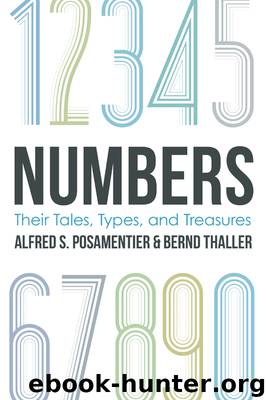Numbers by Alfred S. Posamentier

Author:Alfred S. Posamentier
Language: eng
Format: epub
ISBN: 9781633880313
Publisher: Prometheus Books
Published: 2015-07-17T04:00:00+00:00
Figure 7.9: A map of a general magic square
In a magic square, we would thus have
r2 + c2 + d1 + d2 = 15 + 15 + 15 + 15 = 60.
However, this sum can also be written as
r2 + c2 + d1 + d2 = (d + e + f) + (b + e + h) + (a + e + i) + (c + e + g) =
3 e + (a + b + c + d + e + f + g + h + i) = 3e + 45
Therefore, 3e + 45 = 60, and e = 5. Thus it is established that the center position of a magic square of order 3 must be occupied by the number 5.
Recall that two numbers of an nth order magic square are said to be complementary if their sum is n2 + 1. In a 3 × 3 magic square, two numbers are complementary if their sum is 9 + 1 = 10. We can now see that numbers on opposite sides of 5 are complementary. For example, a + i = d1 – e = 15 – 5 = 10, and, therefore, a and i are complementary. But so are the pairs g and c, b and h, and d and f.
Let us now try to put 1 in a corner, as shown in figure 7.10. Here a = l, and therefore i must be 9, so that the diagonal adds up to 15. Next we notice that 2, 3, and 4 cannot be in the same row (or column) as 1, since there is no natural number less than 9 that would be large enough to occupy the third position of such a row (or column). This would leave only the two shaded positions in figure 7.10 to accommodate these three numbers (2, 3, and 4). Since this cannot be the case, our first attempt was a failure: the numbers 1 and 9 may occupy only the middle positions of a row (or column).
Download
This site does not store any files on its server. We only index and link to content provided by other sites. Please contact the content providers to delete copyright contents if any and email us, we'll remove relevant links or contents immediately.
Modelling of Convective Heat and Mass Transfer in Rotating Flows by Igor V. Shevchuk(6391)
Weapons of Math Destruction by Cathy O'Neil(6139)
Factfulness: Ten Reasons We're Wrong About the World – and Why Things Are Better Than You Think by Hans Rosling(4691)
Descartes' Error by Antonio Damasio(3229)
A Mind For Numbers: How to Excel at Math and Science (Even If You Flunked Algebra) by Barbara Oakley(3217)
Factfulness_Ten Reasons We're Wrong About the World_and Why Things Are Better Than You Think by Hans Rosling(3197)
TCP IP by Todd Lammle(3130)
Fooled by Randomness: The Hidden Role of Chance in Life and in the Markets by Nassim Nicholas Taleb(3043)
Applied Predictive Modeling by Max Kuhn & Kjell Johnson(3018)
The Tyranny of Metrics by Jerry Z. Muller(3000)
The Book of Numbers by Peter Bentley(2907)
The Great Unknown by Marcus du Sautoy(2645)
Once Upon an Algorithm by Martin Erwig(2597)
Easy Algebra Step-by-Step by Sandra Luna McCune(2577)
Lady Luck by Kristen Ashley(2528)
Practical Guide To Principal Component Methods in R (Multivariate Analysis Book 2) by Alboukadel Kassambara(2497)
Police Exams Prep 2018-2019 by Kaplan Test Prep(2481)
All Things Reconsidered by Bill Thompson III(2354)
Linear Time-Invariant Systems, Behaviors and Modules by Ulrich Oberst & Martin Scheicher & Ingrid Scheicher(2331)
